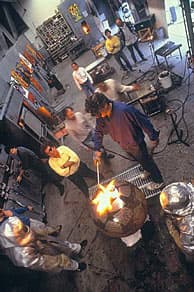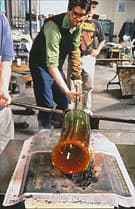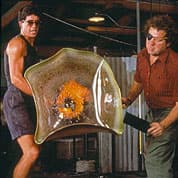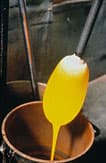
Photograph: Mark Wexler

| A typical glass workshop comprises three to four workers, lead by the gaffer or master blower. Traditionally the gaffer's assistants are divided into servitors, gatherers and bit gatherers. In a contemporary hotshop, the artists often exchange roles, with the initiator of the piece taking the lead. In Chihuly's 'shop - The Boathouse, in Seattle - as many as 18 people will be working at one time. |

Chihuly
hotshop: Jim Mongrain shaping the form on wet newspaper
Photograph: Theresa Batty

Dale Chihuly and William Morris in the hotshop
Photograph: Dick Buscher
Gatherers judge the amount of glass needed; a 'gather' of molten glass is taken from the melting furnace by dipping a blow-pipe. The gather is rotated for uniformity, shaped on a marver or with a forming block, and then the general mass is blown. Using a punty iron, small gathers are added to the mass during the formation of the object. The servitor blows and prepares the basic forms before passing them on. He revolves the object by rolling the blow-pipe back and forth across the arms of the bench. The glass is shaped using a hardwood paddle and a jack, while metal shears of several sizes cut the molten glass.
The gaffer controls the project, shaping and joining the component parts. He must also assess the temperature of the glass and, from time to time during the successive steps of blowing and joining, will return the piece to the glory hole. The gaffer also oversees the gathers brought to him. When the piece is complete a punty is attached to the foot or base, and cracked off from the blow-pipe with the touch of a cold pincher. Finally the piece is carried to the lehr, or annealing oven, where it cools very slowly. Annealing a basic piece requires from five to eight hours, while larger more complicated works often remain in the oven for several days; glass too quickly cooled breaks or has weaknesses.
Heat, gravity and centrifugal force are the most distinctive aspects of Chihuly's glass blowing technique. To learn more, see the video, Chihuly: Installations (KCTS 9, 1992), now showing in the James Fairfax Theatre.
 |
Chihuly hotshop: reheating a Venetian in the gloryhole, The Boathouse, Seattle, Washington, USA Photograph: Russell Johnson |
|
 |
Chihuly
hotshop: dripping the gather Photograph: Theresa Batty |
|